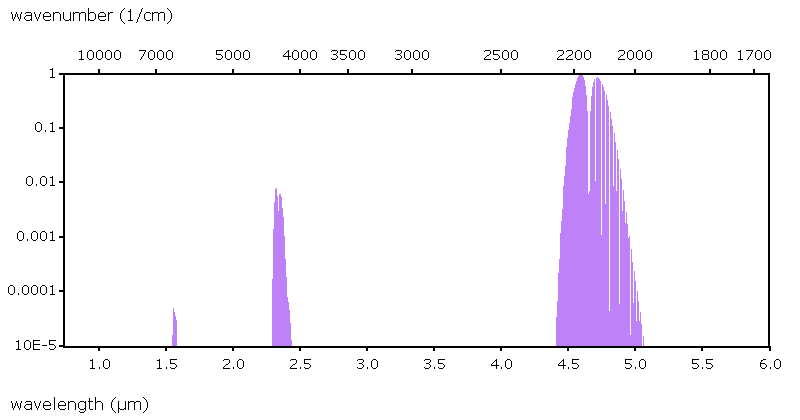

nanoplus lasers detect carbon monoxide in numerous applications, such as in climate monitoring or combustion control, early fire detection, breath gas anaylysis as well as analysis of surgical smoke.
Tunable diode laser spectroscopy allows measuring CO with up to ppb precision in real time and in situ. Providing long-term stability and requiring little maintenance, nanoplus lasers are suitable for operation in harsh environments.

nanoplus offers various wavelengths to target the vibrational-rotational bands of carbon monoxide. Select the target wavelength that fits your application best.
The literature recommends several options. They are illustrated in the graphic on the right, which shows the relative intensities of the possible absorption lines. To define the most suitable CO wavelength for your application, you may have a look at our literature recommendations below or refer to the HITRAN database from the Smithsonian Institute.
We present the most common Distributed Feedback lasers for CO detection below. Learn more about their specifications.

Above wavelengths as well as further customized wavelengths for carbon monoxide detection are available from nanoplus.
When you choose your wavelength, you have to consider your product set up, environment and nature of the measurement.
These factors influence the optimum wavelength for your application. Do have a look at the Hitran Database to further evaluate your choice of wavelengths. Our application experts are equally happy to discuss with you the most suitable wavelength for your application.
Let us know the wavelength you require with an accuracy of 0.1 nm!
We compiled several papers on carbon monoxide detection based on tunable diode laser absorption spectroscopy. Refer to below literature list to read more or select your paper by application.
The relatively new research field of breath analysis defines CO concentration in exhaled breath as a biomarker for e. g. respiratory infections and asthma.
[ 63 ]Early fire detection technologies rely on highly sensitive detection of carbon monoxide. Coal-fired power plants, steel mills or biomass deposits use these smoke detectors to increase process and workers safety.
Oxygen control enhances process and cost efficiency of incinerators. Oxidation requires excess air. But too much air cools down the combustion and increases the amount of CO in the flue gas. Real-time and in situ monitoring helps to optimize the oxygen content in combustion processes.
[ 157 , 154 , 3 ]CO is a major element in high temperature processes. Optimizing CO concentration in flue gas increases combustion efficiency. Simultaneously, it reduces greenhouse gas emissions. CO detection at long wavelengths like 2.8 μm and 4.3 μm uses stronger vibrational absorption features than the shorter wavelength ranges. This effect increases the sensitivity of the detector and allows using measurement set ups with short path lengths.
[ 157 , 154 , 124 , 110 , 48 , 35 , 12 , 3 ]If you have any questions on above wavelengths or require advice on making your choice, our experts will assist you. Just email us or give us a call.